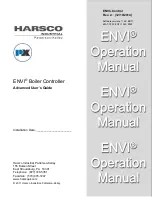
Novar 1xxx
KMB systems
28
•
the difference between reactive power instantaneous value in the power system and
optimum value, which corresponds to the target power factor setting (= control deviation),
is just equal to the smallest section power (C/k
MIN
)
If the parameter value is set to say 3.0 and the above mentioned conditions are met in the power
system, the controller calculates optimum compensation and carries out control intervention every 3
minutes.
The time mentioned gets shorter in proportion to the instantaneous control deviation. If control time
without preceding character “L” is set, it gets shorter as square of control deviation over the smallest
section value (C/k
MIN
). If the control time with preceding character “L” is specified, it gets shorter in
proportion to this ratio (“L” = Linear, causes slower response to large deviations). Rising control
deviation can decrease this value to the minimum control time of 5 seconds.
On the contrary, if the control deviation is smaller than the smallest section power (C/k
MIN
), control time
gets twice as long. If the control deviation falls further under half of the smallest section power value
(C/k
MIN
), no control interventions take place.
4.1.4 Parameter 03/09 – Overcompensation Control Time
The value for metering rate 1 (parameter 03) or for metering rate 2 (parameter 9) determines the
frequency of control interventions, very much like in parameter 02/08 described above. There is
a difference though: it only applies if the instantaneous power factor is more capacitive than that
required, that is it is overcompensated.
The control time operation in proportion to control deviation magnitude is the same as with parameter
02/08 described above.
4.1.5 Parameter 04/10 – Control Bandwidth on High Loads
Using this parameter you can specify the control bandwidth on high loads (see Figure 4.1). The value
entered specifies the range of reactive power in the C zone which constitutes condition considered as
compensated, making the controller stop control interventions.
Figure 4.1: Standard Control Bandwidth
reactive
power
(L)
control bandwidth
active
power
(+)
instantaneous
power
vector
B
C
A
+0,005
power factor specified
-0,005
On low loads (zone A) and on medium loads (zone B), the control bandwidth is constant and
corresponds to the C/k
min
value – the band follows the power factor slope specified at width
± (C/k
MIN
)/2. On high loads (zone C) the bandwidth increases so its limits correspond to adjustable
deviation from the target power factor. The standard bandwidth value in this zone is 0.010 or ± 0.005
– this condition is shown in Figure 4.1. If thus, for example, the target power factor is specified as
0.98, reactive power corresponding to power factor from 0.975 to 0.985 will be considered
compensated condition in zone C.
Summary of Contents for NOVAR-1 Series
Page 66: ...Novar 1xxx KMB systems 66 Novar1106 installation...
Page 67: ...Novar 1xxx KMB systems 67 Novar1114 installation...
Page 68: ...Novar 1xxx KMB systems 68 Novar1206 installation low voltage measurement...
Page 69: ...Novar 1xxx KMB systems 69 Novar1214 installation high voltage measurement...
Page 70: ...Novar 1xxx KMB systems 70 Novar1114 S400 installation...
Page 73: ...Novar 1xxx KMB systems 73 Novar1414 installation low voltage measurement...
















































